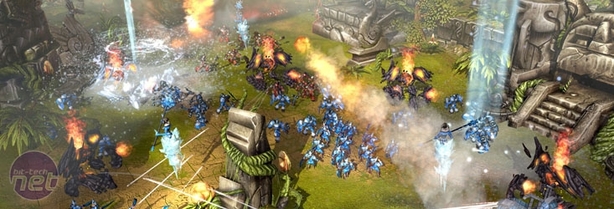
Battleforge Impressions
Truth be told, Battleforge is as interesting outside of the game as it is inside and it has a wide variety of community features which should sit well with gamers who like to interact with other players.The fact that Battleforge has an in-game store for buying booster packs is something we’ve already discussed, but there’s also an option for players to trade amongst themselves and undercut the developers if they want, even trading cards directly if they choose.
EA Phenomic has put an awful lot of thought into this trading system though, creating two forms of in-game currency to help try and prevent the gold farmers and exploiters who might be attracted to the market.
The first form of in-game money is Battleforge Points, which is basically a representation of in-game cash. Real money gets turned into BF Points before you can buy booster packs or trade with players.
Confusingly though, the other type of game currency is called Gold, but bears no relation to actual money. Instead, Gold is used to chart something closer to in-game experience. You earn Gold by completing missions in game, but it has no real trade value. It’s all a little bit silly if you ask us.
EA Phenomic’s hope though is that it can use the Gold system to deter would-be gold farmers and profiteers who do underhand deals and exploits to get hold of the ultra-rare cards. By putting certain restrictions on how much Gold you must have before you can sell certain cards, Phenomic is slowing down farmers and hopefully making the practice unprofitable.
Thus, for farmers it’s no longer a case of just paying some Chinese infant to recognise the good cards and how to sell them, you’ll also need to have them win a whole bunch of matches using the card. Boom! The economy is saved!
For actual players meanwhile, nothing changes. Those who are interested in actually learning the game and doing more than just profiting from it will earn gold transparently and are unlikely to want to sell their powerful cards at first. Hopefully, by the time you do want to start player trading you’ll already have the required amount of Gold.
The one problem with Battleforge though is one that’s pretty inescapable and extremely obvious – the concept may just be too weird and unfamiliar for a mass audience. We’ve seen the game on two separate occasions now, sitting down with both the lead designer for the game and also some of the developers, but we’ve still struggled to get our noggins around it all.
In some ways we suspect that Battleforge may be a little bit ahead of its time. One undeniable thing about hardcore PC gaming is that singleplayer is getting a less attractive option to many players, with online and co-op play rapidly replacing it. PC piracy is also forcing developers to find new ways to authenticate their system without all that unpopular DRM. It’s also forcing publishers to look at new ways to finance the games.
All those things, Battleforge does through its online-only gameplay and a well designed, secure player client. The issue though is that the market may not be totally ready for the sudden move because, although games are starting to head down that road, they really aren’t doing it en masse quite yet. There are still a lot more singleplayer games than MMOs, for example.
Regardless of how intimidating a sale Battleforge may be for the market at the moment though, one thing we know for certain is that the game is both ingenious and addictive, with a steadily fun gameplay at the core and a solid business model wrapped around it. If gamers turn out to be ready for Battleforge afterall, then we have no doubt that it could be the Next Big Thing.
Battleforge will launch as a PC Exclusive in 2009, but there’s still no defined release date – but keep an eye on the Gaming Channel for a later review.

MSI MPG Velox 100R Chassis Review
October 14 2021 | 15:04











Want to comment? Please log in.